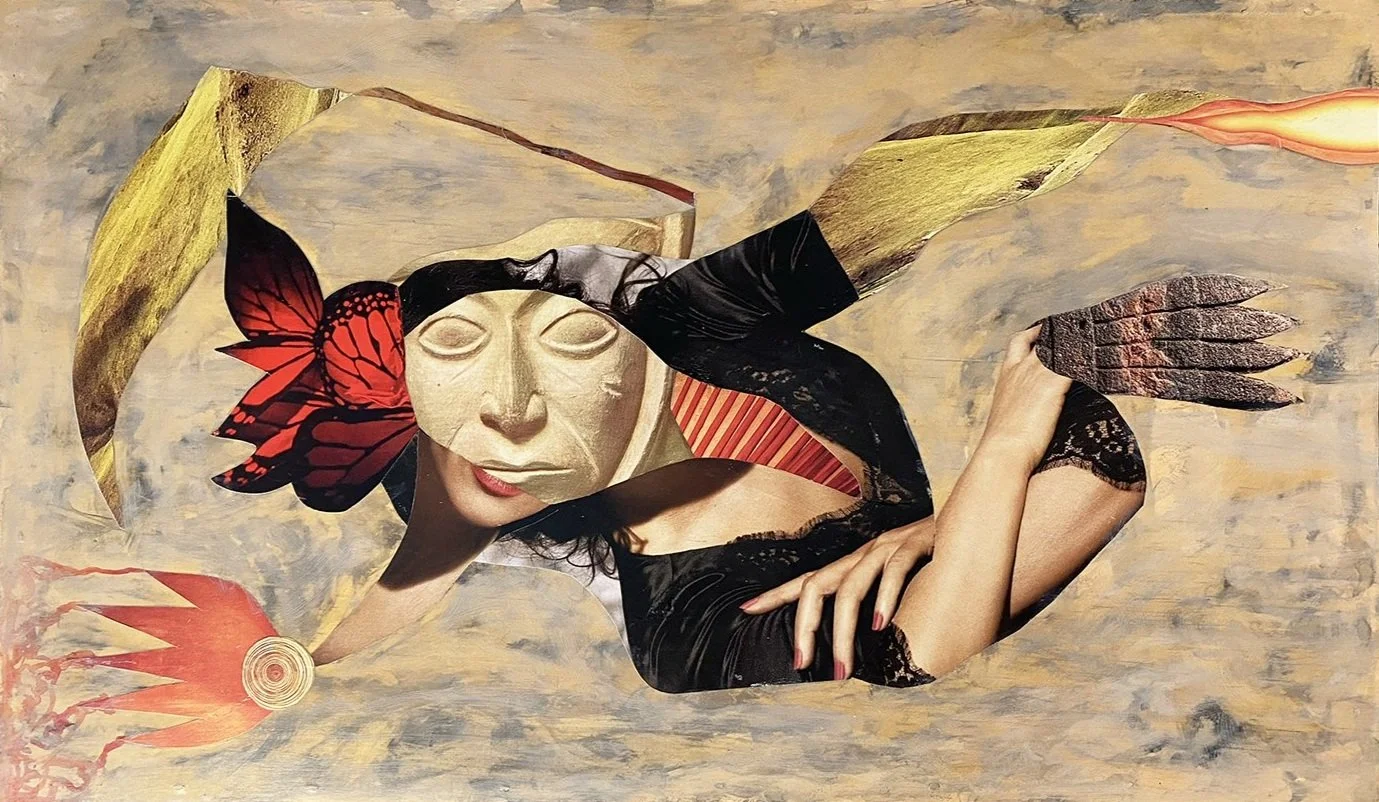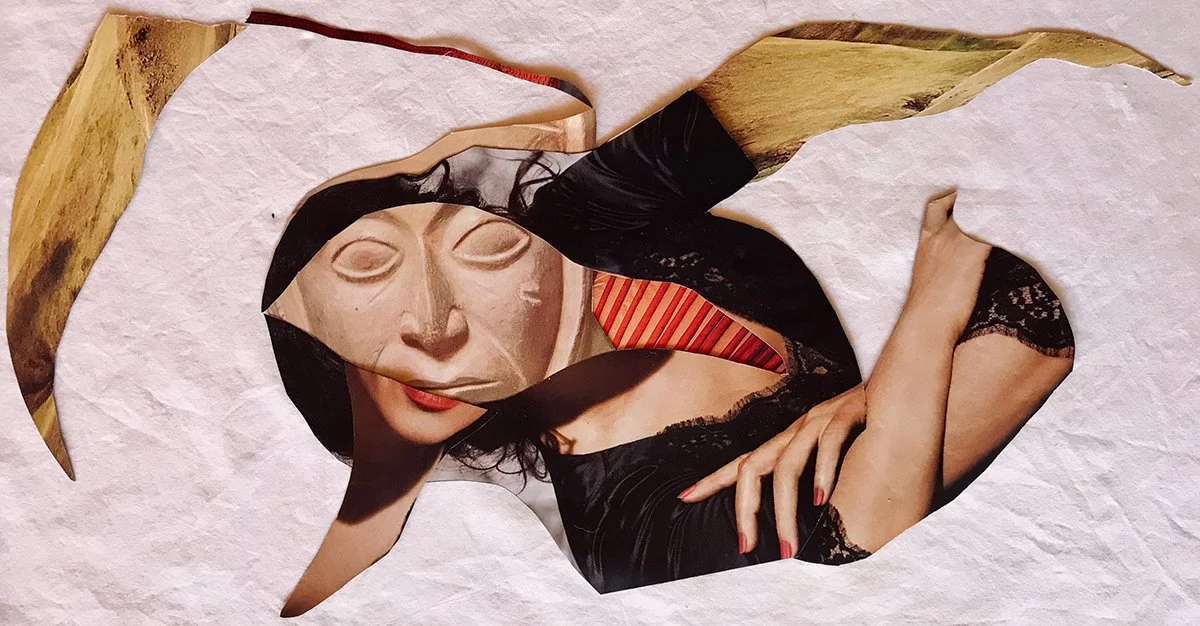The Stone Witch — Part I
The Stone Witch, by Christy Higgins, Mixed-media collage on wood box panel 12 1/4” x 21”, 2021. Original artwork and prints available.
The first time I met the unwavering gaze of the Stone Witch, my husband and I had recently reunited after a three-month separation I initiated in the Fall of 2020. It was January 2021 and we had embarked on a month-long retreat on the outskirts of Oaxaca City, Mexico. While we were both committed to working through the contentiousness that had been building between us, we really didn’t know how the month would play out when we arrived with our two dogs at our cottage in the woods.
In addition to putting some deeper attention on our relationship, Dan and I brought our personal art projects to work on in between long talks, nature walks, and naps. With more time on our hands during the pandemic, I had begun to experiment with collage only a few months before, so I brought supplies along to continue developing this new-to-me craft.
One afternoon, an image began to appear in a composition. (Below) When I first saw her, I felt a little thrill. That excitement, however, was soon tinged with some portending. Who was this menacing-looking character? I wasn’t sure I wanted to know; she both fascinated and unnerved me. As intrigued as I was, I also wanted to make her go away. Rather than running away, however, I asked myself who this wicked seeming woman might be.
An early rendition of The Stone Witch
From my very first experiments with collage, the images that emerged were not what most who know me, or I myself for that matter, would have expected. They weren’t pretty or realistic or peaceful, but rather, surreal, complex, and, at first, inscrutable. I couldn’t help but wonder where these images were coming from.
Over the next few years, while indulging in my other favorite pastime—studying mythology, depth psychology, and psychospirituality—my images began to reveal deeper layers to me. Time and time again, I would read about a mythological motif or an archetypal complex and something would hit me: That’s what (that image) is about! One such image was this ancient stone-faced goddess who announced herself while my husband and I were regrouping in Oaxaca.
While I had some intuition about her, I wasn’t certain what she represented. My working title for months had been Woman Possessed by an Ancient Goddess (which still resonates with me). Recently, however, while reading Leaving My Father’s House: A Journey to Conscious Femininity by Marion Woodman, et al, I came across a concept that co-author Mary Hamilton calls “the Stone Witch.” I was immediately reminded of this image and thought: That’s who the frightening goddess is! The Stone Witch!
Hamilton contends that the “Stone Witch” is a formidable archetype within her that she feels is devouring her and the life around her. The author has much more to say about her Stone Witch, all of which helped illuminate the ways in which this archetypal energy was also living within me. It manifests in each person somewhat differently, but I recognized the basic feeling of raw, overpowering, destructive energy based in rage that was not always in my control. I have behaved at times as if I was a woman possessed. She has made her unwelcome appearance most often in my relationship with my mother (more on that later in the series when I discuss intergenerational trauma) and has been strongly reflected in my romantic relationships with men.
At some point, it dawned on me that I was, perhaps, looking at a visual representation of what the founder of analytical psychology, Dr. Carl Jung, identified as a “complex” abiding within my unconscious. Not familiar? Let’s dig into this a bit.
So, what are archetypes and psychological complexes, and what do they have to do with you and me?
According to Very Well Mind...
“Archetypes” are universal, inborn models of people, behaviors, and personalities that play a role in influencing human behavior. Jung's theory suggested that these archetypes were archaic forms of innate human knowledge passed down from our ancestors… in much the same way we inherit instinctive patterns of behavior.
Distinct from archetypes, as defined by Springer Encyclopedia,
A “complex” is an unconscious organized set of memories, associations, fantasies, expectations, and behavior patterns or tendencies around a core element that is accompanied by strong emotions. It is derived from early developmental experiences that have a problematic or even traumatic character circling around unresolved needs and topics. The complex can be triggered in later life by structurally similar cues, e.g., situations or relationships. The complex takes hold of the person and is accompanied by strong emotions and typical behavior patterns influenced by the complex.
In summary, complexes are to the personal unconscious what archetypes are to the collective unconscious. According to Jung, the personal unconscious is the accumulation of experiences from a person’s lifetime that cannot be consciously recalled. The collective unconscious, on the other hand, is a sort of universal inheritance of human beings—a “species memory” passed on to each of us—not unlike the motor programs and instincts of other animals. What they both have in common is that these are patterns of energy (or thought) that affect us unconsciously in both the personal and collective dimensions of our psyche.
Which brings us back to my Stone Witch. This mythological motif emerged in my collage unconsciously, and by asking myself who the Stone Witch within me was, I began the process of bringing her icy rage back into my conscious awareness. And by contemplating how she shows up in my relationships, I started to see more of her in my marriage.
As Hamilton describes in the aforementioned book, the Stone Witch is the part of our shadow that has no love, no joy, and no laughter. Her boundaries have been so profoundly violated that she has become burdened by life, marriage, relationships, and anyone who needs to be nurtured, cared for, or loved.
While the Stone Witch isn’t the totality of who I am by any stretch of the imagination, this psychic energy derived from fear and unprocessed grief had started to occupy more and more of my personality as the years progressed. Despite the fact that I can be a loving, empathetic, kind, and generous person, on more occasions than I care to admit, I have also been an out-of-control, righteous, raging bitch. We call the circumstances that awaken our complexes “triggers,” and they can seem to come out of nowhere. When the Stone Witch gets triggered, she activates an emotional storm that comes over me like a possession, and is often followed by a shame spiral from which it takes hours or days to recover my more loving, balanced, and affable self. When all is well, I’m a caring, well-balanced person; but when someone pushes my “I’m not safe or valued” button the Stone Witch gets activated. This unconscious, energetic pattern is what was rearing its ugly head in my marriage.
No one likes the Stone Witch; naturally, she gets a bad rap. However, becoming aware of her energy within us is the first step toward healing repressed anger and despair. It’s one thing to recognize a harmful pattern about yourself; it’s another to actively work to heal that complex at its source. Our complexes grow in the dark, where they live out their grievances over and over again, waiting for an opportunity to express themselves.
In Part II of The Stone Witch Series, I’ll describe how being a pent-up “good girl” was wreaking havoc on my relationships, most notably my marriage. Later in the series I will tell the more personal side of how I became a People Pleaser, what I’m doing to integrate this hair-raising witch back into the fold of my awareness (back under my conscious control), and how art can help us to heal the intergenerational wounds that run deep in our collective psyche.
RESOURCES & FURTHER READING:
Woodman, Marion. Leaving My Father’s House: A Journey to Conscious Femininity. 1992.
Johnson, Robert A. Owning Your Own Shadow. Harpercollins, 1991


